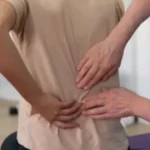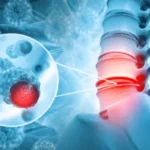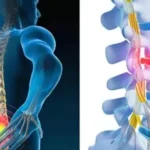Understanding Spinal Stenosis in Elderly Patients
Around 1 in 1000 people older than 65 develop spinal stenosis posing a major health issue among seniors. This condition happens when spaces in the spine get smaller causing pressure on the nerves that pass through them. Aging brings natural wear and tear to spinal structures leaving older adults more at risk for this problem.

The spine protects the spinal cord and works as the main support for the body. Over many years, it undergoes wear and tear. Medical studies reveal that around 80% of people above 70 display stenotic changes on MRIs, although many do not show symptoms. These numbers show why learning about this condition matters to care for older adults.
Why Spondylosis Affects the Elderly Population
Recent studies in medicine show that more than 85% of people older than 60 experience spondylosis. This term describes overall spine degeneration that happens as people get older. It differs from spinal stenosis, which is when the spinal canal narrows. Spondylosis includes wider problems like discs drying out, bone spurs appearing, and facet joints becoming bigger and worn out.
Aging causes big changes in the spine:
- The discs between bones lose water and become stiff
- Ligaments grow thicker and harder
- Bone spurs show up along the edges of the spine
- Facet joints break down and get larger
These changes appear in everyone as they grow older, which helps explain why spondylosis affects so many older adults.
Common Spinal Stenosis Symptoms to Watch For
Spotting spinal stenosis symptoms can make treatments work better. The signs show up over time and might include the following:
- Pain or cramps in the legs during walking or standing for long stretches
- Tingling or numbness in the feet, legs, or buttocks
- Weak legs or issues like “foot drop”
- Back pain (though this doesn’t always happen)
- In more serious cases, trouble with bladder or bowel control
A key sign of spinal stenosis involves neurogenic claudication. This is leg pain that gets worse when walking but feels better when sitting or leaning forward. Bending forward opens up space in the spinal canal and eases nerve pressure for a while.
Recognizing Spondylosis Symptoms Early
Neck pain, stiffness, and tingling in hands or feet often show up as early signs of spondylosis. If it impacts the neck area (cervical spine) common issues include:
- Ongoing neck pain spreading to arms or shoulders
- Less flexibility and stiffness in the neck
- Pain or pressure at the back of the head
- Feeling or hearing grinding when turning your neck
- Weakness or numbness in the arms
Lower back pain, stiffness, and sometimes nerve issues in the legs are common signs of lumbar spondylosis. Noticing these signs helps to act fast and manage the condition better.
Advanced Spinal Stenosis Treatment Options Available
Doctors now use treatments for spinal stenosis that go from basic care to less invasive operations. Care plans often take a step-by-step approach.
- Conservative Treatments:
- Use NSAIDs to manage pain.
- Engage in physical therapy exercises.
- Take steroid injections when advised.
- Change daily activities to reduce strain.
- Rely on assistive devices for additional support.
- Less Invasive Options:
- Perform endoscopic decompression using a tiny 7mm cut.
- Try percutaneous techniques to address the issue.
- Use image-guided injections to target problem areas.
- Surgical Options (if required):
- Undergo a lumbar laminectomy.
- Consider lumbar fusion with less invasive approaches.
- Explore Extreme Lateral Interbody Fusion (XLIF).
Endoscopic treatments offer quicker recovery and work well for elderly patients. They avoid complex surgeries and long healing times making them a better choice for older individuals.
Consulting a Specialist in Endoscopic Spine Surgery for Treatment
Sant Paramanand Hospital provides relief to patients looking for Delhi’s best endoscopic spine surgeon in delhi. Dr. Amit Shridhar, who has been practicing for over 20 years, focuses on invasive spine surgeries. He has assisted many older individuals in walking again and easing their long-term pain.
Elderly patients gain many benefits from endoscopic spine surgery:
- Small cuts that measure 7mm and limit tissue harm
- Less blood loss than typical surgery
- A lower chance of infections
- Fewer days spent in the hospital
- Quicker healing processes
- Reduced discomfort after surgery
These advantages matter greatly to older patients since health issues tied to age can make recovering from open surgeries tougher.
Getting the Right Specialist for Your Spine Condition
To find a best spine doctor in delhi for your needs, focus on those who have skills in invasive methods. Key things to look for include:
- Expertise in treating older people with spine problems
- Skills in using endoscopic and invasive procedures
- A complete and well-rounded way of treating patients
- Feedback from other patients about their experiences
- The quality of the hospital and support available
Sant Paramanand Hospital in Delhi provides advanced care for spine issues. Their specialists understand the specific problems elderly patients face with spinal conditions.
Managing Back Discomfort in the Elderly
Treating Back pain relief means combining medical care with changes to daily habits. Elderly people dealing with spinal stenosis or spondylosis benefit most from a mix of different methods:
- Getting the right medical care based on what the doctor finds
- Doing physical therapy exercises to strengthen the core
- Adding light activities like walking or swimming
- Using good posture and moving the body
- Managing weight
- Choosing supportive furniture or tools that help
- Using heat or ice packs for relief
The best back pain doctor in Delhi designs complete treatment plans for older patients. These plans consider the patient’s specific health and needs.
Patient Case Study: Recovery from Severe Spinal Stenosis
Patient Overview: A 72-year-old man struggling with severe lumbar spinal stenosis
Challenges: Walking had become harder accompanied by leg pain and numbness lasting more than two years
Earlier Treatments Tried: He had used pain medicine, done physical therapy, and had epidural injections, but these brought little relief
The patient met with Dr. Amit Shridhar at Sant Paramanand Hospital. He decided to have endoscopic decompression surgery. The operation took less than 2 hours and involved very little blood loss. The patient started walking the same day and left the hospital within 24 hours.
Results: After three months, he shared his progress:
- Leg pain reduced by 90 percent
- Walking 30 minutes without pain possible
- Life quality improved in a big way
- Back to regular daily routines
“This feels like a second chance at life, and I owe it all to him,” the patient said when talking about recovery and the experience.
Comparison of Treatment Options for Elderly Spine Patients
| Treatment Approach | Benefits | Considerations for Elderly | Recovery Time |
| Conservative Management | Non-invasive, low risk | May provide insufficient relief for advanced cases | Varies based on response |
| Epidural Injections | Targeted pain relief, outpatient procedure | Temporary relief, may need repetition | 1-3 days |
| Traditional Open Surgery | Addresses severe cases | Higher surgical risk, longer recovery | 3-6 months |
| Endoscopic Spine Surgery | Minimally invasive, less tissue damage | Excellent option for elderly, lower complications | 2-6 weeks |
| Spinal Fusion | Stabilizes spine | Extended recovery, may limit mobility | 6-12 months |
How Spinal Stenosis Elderly Patients Can Improve Quality of Life
Caring for elderly patients with spinal stenosis takes special attention and understanding of how aging affects them. Besides medical care, there are different ways to help them live better:
- Staying active with exercises that keep muscles strong and joints moving
- Eating well to keep bones healthy
- Using tools like canes or walkers when needed
- Making homes safer to avoid falls
- Finding ways to handle pain
- Connecting with others and looking after mental health
With the right support and a good medical team elderly people with spinal stenosis can stay independent and still have a fulfilling life despite their challenges.
Frequently Asked Questions
What is spinal stenosis and how does it differ from spondylosis?
Spinal stenosis happens when spaces in the spine become narrow, which can press on the nerves. Spondylosis is a general term used to describe age-related wear and tear on the spine. It includes things like worn-out discs, bone spurs, or changes in the facet joints. While spondylosis can cause spinal stenosis, not everyone with spondylosis will end up having stenosis.
At what age do these conditions typically develop?
These problems can happen at any age due to birth defects or injuries. They tend to become more frequent in people over 50. By the time someone turns 60 about 85 out of 100 people have some level of spondylosis. By 70 about 8 in 10 show signs of stenosis on scans.
Is surgery always necessary for spinal stenosis or spondylosis?
Surgery isn’t always needed. Many people improve with physical therapy, medications, or changing daily habits. Doctors think about surgery if these options don’t work or when nerve problems keep getting worse.
What makes endoscopic spine surgery better for elderly patients?
Endoscopic spine surgery involves smaller cuts around 7mm. It leads to less damage to tissue, reduces blood loss, and helps patients heal faster when compared to traditional open surgery. These benefits make it a good option for older people who may already have health problems or less physical strength.
How long is the recovery period after endoscopic spine surgery?
Most people can start light tasks in 1-2 weeks and get back to regular activities within 4-6 weeks. This recovery period is much shorter compared to the 3-6 months or more that open spine surgery takes.
Who is the right expert to consult for back issues in older adults?
Older adults with spine issues should consult doctors skilled in treating elderly patients and using modern invasive methods. The team at Sant Paramanand Hospital, known for having some of the best doctors for back pain in Delhi, provides detailed assessments and customized care plans to address spine problems in senior patients.
Conclusion
Spinal stenosis and spondylosis are typical spine problems that come with aging and affect many elderly individuals. Knowing about conditions like spinal stenosis and spondylosis can help people choose the right treatment path. Newer techniques like endoscopic spine surgery make it easier for older patients to get effective care with shorter recovery and fewer risks.
If you or someone close to you has symptoms of these conditions, seeing the top spine doctor in Delhi who focuses on minimally invasive treatments can lead to recovery and better living. Sant Paramanand Hospital provides complete care to treat spine issues aiming to put the patient’s needs first while using advanced techniques.



